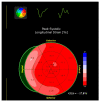Novel Biomarkers and Advanced Cardiac Imaging in Aortic Stenosis: Old and New
- PMID: 38002343
- PMCID: PMC10669288
- DOI: 10.3390/biom13111661
Novel Biomarkers and Advanced Cardiac Imaging in Aortic Stenosis: Old and New
Abstract
Currently, the symptomatic status and left ventricular ejection fraction (LVEF) play a crucial role in aortic stenosis (AS) assessment. However, the symptoms are often subjective, and LVEF is not a sensitive marker of left ventricle (LV) decompensation. Over the past years, the cardiac structure and function research on AS has increased due to advanced imaging modalities and potential therapies. New imaging parameters emerged as predictors of disease progression in AS. LV global longitudinal strain has proved useful for risk stratification in asymptomatic severe AS patients with preserved LVEF. The assessment of myocardial fibrosis by cardiac magnetic resonance is the most studied application and offers prognostic information on AS. Moreover, the usage of biomarkers in AS as objective measures of LV decompensation has recently gained more interest. The present review focuses on the transition from compensatory LV hypertrophy (H) to LV dysfunction and the biomarkers associated with myocardial wall stress, fibrosis, and myocyte death. Moreover, we discuss the potential impact of non-invasive imaging parameters for optimizing the timing of aortic valve replacement and provide insight into novel biomarkers for possible prognostic use in AS. However, data from randomized clinical trials are necessary to define their utility in daily practice.
Keywords: aortic stenosis; cardiac biomarkers; myocardial fibrosis; remodeling; risk assessment.
Conflict of interest statement
The authors declare no conflict of interest.
Figures




Similar articles
-
Role of advanced left ventricular imaging in adults with aortic stenosis.Heart. 2020 Jul;106(13):962-969. doi: 10.1136/heartjnl-2019-315211. Epub 2020 Mar 16. Heart. 2020. PMID: 32179586 Free PMC article. Review.
-
Aortic Stenosis, a Left Ventricular Disease: Insights from Advanced Imaging.Curr Cardiol Rep. 2016 Aug;18(8):80. doi: 10.1007/s11886-016-0753-6. Curr Cardiol Rep. 2016. PMID: 27384950 Free PMC article. Review.
-
Cardiovascular magnetic resonance imaging to assess myocardial fibrosis in valvular heart disease.Int J Cardiovasc Imaging. 2018 Jan;34(1):97-112. doi: 10.1007/s10554-017-1195-y. Epub 2017 Jun 22. Int J Cardiovasc Imaging. 2018. PMID: 28642994 Free PMC article. Review.
-
Incremental Prognostic Use of Left Ventricular Global Longitudinal Strain in Asymptomatic/Minimally Symptomatic Patients With Severe Bioprosthetic Aortic Stenosis Undergoing Redo Aortic Valve Replacement.Circ Cardiovasc Imaging. 2017 Jun;10(6):e005942. doi: 10.1161/CIRCIMAGING.116.005942. Circ Cardiovasc Imaging. 2017. PMID: 28559420
-
Association of Left Ventricular Global Longitudinal Strain With Asymptomatic Severe Aortic Stenosis: Natural Course and Prognostic Value.JAMA Cardiol. 2018 Sep 1;3(9):839-847. doi: 10.1001/jamacardio.2018.2288. JAMA Cardiol. 2018. PMID: 30140889 Free PMC article.
Cited by
-
Comparing Early Intervention to Watchful Waiting: A Review on Risk Stratification and Management in Asymptomatic Aortic Stenosis.Medicina (Kaunas). 2025 Mar 4;61(3):448. doi: 10.3390/medicina61030448. Medicina (Kaunas). 2025. PMID: 40142259 Free PMC article. Review.
-
Shaping the Optimal Timing for Treatment of Isolated Asymptomatic Severe Aortic Stenosis with Preserved Left Ventricular Ejection Fraction: The Role of Non-Invasive Diagnostics Focused on Strain Echocardiography and Future Perspectives.J Imaging. 2025 Feb 8;11(2):48. doi: 10.3390/jimaging11020048. J Imaging. 2025. PMID: 39997550 Free PMC article. Review.
-
Matrix Metalloproteinases: Pathophysiologic Implications and Potential Therapeutic Targets in Cardiovascular Disease.Biomolecules. 2025 Apr 17;15(4):598. doi: 10.3390/biom15040598. Biomolecules. 2025. PMID: 40305314 Free PMC article. Review.
-
Serum ACE2 activity as a novel biomarker of assessment of severe aortic stenosis.Geroscience. 2025 Jul 15. doi: 10.1007/s11357-025-01792-6. Online ahead of print. Geroscience. 2025. PMID: 40665095
-
Effect of obesity on cardiovascular morphofunctional phenotype: Study of Mendelian randomization.Medicine (Baltimore). 2025 Mar 28;104(13):e41858. doi: 10.1097/MD.0000000000041858. Medicine (Baltimore). 2025. PMID: 40153760 Free PMC article.
References
Publication types
MeSH terms
Substances
LinkOut - more resources
Full Text Sources
Medical
Research Materials
Miscellaneous

